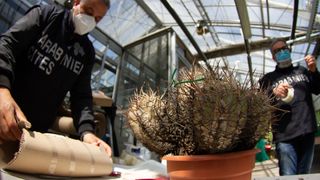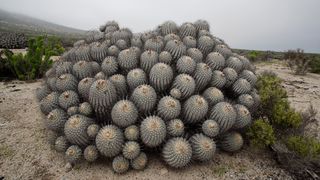$1.2 million worth of rare, stolen cactuses confiscated and returned to Chile
Officials recovered the cactuses during two raids in Italy, in 2020.

Rare cactuses taken illegally from the driest place on Earth are finally going home.
Cactuses in the genuses Copiapoa and Eriosyce grow in arid regions in northern Chile, such as the Atacama Desert, and a number of these species are highly prized by specialist collectors for landscaping and as houseplants. However, Chile does not allow export of the cactuses, making them a popular target for poachers. Hundreds of the plants were stolen from the wild between 2013 and 2019, representatives of the International Union for Conservation of Nature (IUCN) said in a statement on April 26.
Officials confiscated 1,035 of the illegally traded cactuses in Italy during two raids in 2020 — the largest such seizure in Italy to date, IUCN representatives reported in December. These raids were the culmination of a yearlong effort called "Operation Atacama," in which Italian and Chilean authorities collaborated with the IUCN to recover stolen plants and send them back to Chile, according to the April statement.
Related: Cholla photos: See these amazing desert cacti
During the first cactus confiscation raid, in February 2020, officials found hundreds of Copiapoa and Eriosyce cactuses in Senigallia, Italy, a port town on the coast of the Adriatic Sea. Nine months later, in November 2020, Operation Atacama retrieved 171 more plants in Rimini, Italy — 80 from Chile, 89 from Mexico and two from the United States, the IUCN said in December.
Not all of the recovered cactuses survived the rescue mission, and 107 died before they could be returned to Chile; an additional 84 are staying behind in Italy at the Città Studi Botanical Garden in Milan, for researchers to study. The remaining 844 Chilean plants went back to their country of origin on April 19, and they will be relocated in the wild after a period in quarantine, to make sure they aren't carrying invasive pests or diseases that could spread to other Chilean desert plants, according to the IUCN.
Many cactus species grow in the Americas, but they are also found in Mediterranean countries, Australia and South Africa. Chile's Copiapoa and Eriosyce cactuses, which are among the rarest in the world, can fetch as much as $1,500 per plant on the black market in Europe and Asia, the IUCN says. The purloined collection recovered by Operation Atacama is worth an estimated $1.2 million, The New York Times reported on May 20.
Sign up for the Live Science daily newsletter now
Get the world’s most fascinating discoveries delivered straight to your inbox.

Cactuses come in many striking shapes, from the tall, many-armed saguaro (Carnegiea gigantea) in the Sonoran Desert to Chile's squat, long-spined Copiapoa dealbata. Many cactus species grow only in low abundance in small geographic ranges, making the plants "extremely attractive to collectors" around the globe, the IUCN said in December.
Trading of illegally collected cactuses frequently takes place in plain sight, with poached succulents displayed in plant shops, advertised on social media and hawked in online marketplaces, according to the Times.
"Poachers sometimes livestream videos from the field, asking customers which plants they want," the Times reported.
The cactuses endure extremely dry conditions and punishing extremes of heat and cold, but their biggest threat is human activity. In addition to poaching, development of the cactuses' desert ecosystems uproots and transforms their homes to make room for farms, ranches, residences and industry. To date, approximately 2,000 species of the 10,000 known succulents worldwide are threatened with extinction in the wild, the IUCN recently reported.
Originally published on Live Science.

Mindy Weisberger is an editor at Scholastic and a former Live Science channel editor and senior writer. She has reported on general science, covering climate change, paleontology, biology, and space. Mindy studied film at Columbia University; prior to Live Science she produced, wrote and directed media for the American Museum of Natural History in New York City. Her videos about dinosaurs, astrophysics, biodiversity and evolution appear in museums and science centers worldwide, earning awards such as the CINE Golden Eagle and the Communicator Award of Excellence. Her writing has also appeared in Scientific American, The Washington Post and How It Works Magazine.
Most Popular



